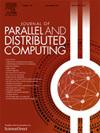异构高性能计算机上晶格玻尔兹曼方法的单节点负载均衡优化
IF 4
3区 计算机科学
Q1 COMPUTER SCIENCE, THEORY & METHODS
引用次数: 0
摘要
晶格玻尔兹曼方法(LBM)特别适合于在混合cpu和gpu的异构HPC系统上进行高度并行的计算流体动力学模拟。然而,计算上占主导地位的碰撞和流循环通常只利用gpu,使CPU资源未充分利用。为了克服这一限制,本文提出了一种基于遗传算法的新型负载平衡策略,用于自下而上、成本感知的空间域分解优化。这种方法生成子域和等级分配,本质上适合在cpu和gpu上协同执行。该策略在开源框架OpenLB中实现,应用于湍流参考案例,包括多物理场反应混合器。对异构HPC节点的详细评估显示了显著的性能提升,与传统的纯gpu执行相比,实现了高达87%的速度提升。因此,这项工作建立了成本感知的、自底向上的分解,作为利用现代计算节点的本地异构性的合适策略。本文章由计算机程序翻译,如有差异,请以英文原文为准。
Optimization of single node load balancing for lattice Boltzmann method on heterogeneous high performance computers
Lattice Boltzmann Methods (LBM) are particularly suited for highly parallel computational fluid dynamics simulations on heterogeneous HPC systems combining CPUs and GPUs. However, the computationally dominant collide-and-stream loops commonly utilize only GPUs, leaving CPU resources underutilized. To overcome this limitation, this article proposes a novel load balancing strategy based on a genetic algorithm for bottom-up, cost-aware optimization of spatial domain decompositions. This approach generates subdomains and rank assignments inherently suited for cooperative execution on both CPUs and GPUs. Implemented in the open source framework OpenLB, the strategy is applied to turbulent flow reference cases, including a multi-physics reactive mixer. A detailed evaluation on heterogeneous HPC nodes demonstrates significant performance gains, achieving speedups of up to 87% compared to traditional GPU-only execution. This work therefore establishes cost-aware, bottom-up decomposition as a suitable strategy for exploiting the native heterogeneity of modern compute nodes.
求助全文
通过发布文献求助,成功后即可免费获取论文全文。
去求助
来源期刊

Journal of Parallel and Distributed Computing
工程技术-计算机:理论方法
CiteScore
10.30
自引率
2.60%
发文量
172
审稿时长
12 months
期刊介绍:
This international journal is directed to researchers, engineers, educators, managers, programmers, and users of computers who have particular interests in parallel processing and/or distributed computing.
The Journal of Parallel and Distributed Computing publishes original research papers and timely review articles on the theory, design, evaluation, and use of parallel and/or distributed computing systems. The journal also features special issues on these topics; again covering the full range from the design to the use of our targeted systems.
 求助内容:
求助内容: 应助结果提醒方式:
应助结果提醒方式:


